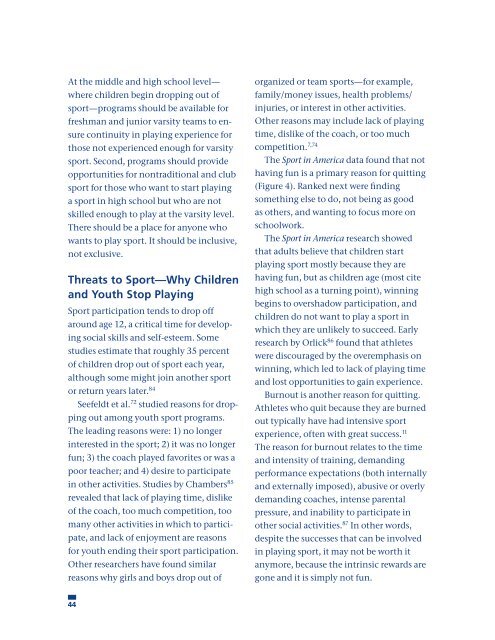True-Sport-Report
Create successful ePaper yourself
Turn your PDF publications into a flip-book with our unique Google optimized e-Paper software.
At the middle and high school level—<br />
where children begin dropping out of<br />
sport—programs should be available for<br />
freshman and junior varsity teams to ensure<br />
continuity in playing experience for<br />
those not experienced enough for varsity<br />
sport. Second, programs should provide<br />
opportunities for nontraditional and club<br />
sport for those who want to start playing<br />
a sport in high school but who are not<br />
skilled enough to play at the varsity level.<br />
There should be a place for anyone who<br />
wants to play sport. It should be inclusive,<br />
not exclusive.<br />
Threats to <strong>Sport</strong>—Why Children<br />
and Youth Stop Playing<br />
<strong>Sport</strong> participation tends to drop off<br />
around age 12, a critical time for developing<br />
social skills and self-esteem. Some<br />
studies estimate that roughly 35 percent<br />
of children drop out of sport each year,<br />
although some might join another sport<br />
or return years later. 84<br />
Seefeldt et al. 72 studied reasons for dropping<br />
out among youth sport programs.<br />
The leading reasons were: 1) no longer<br />
interested in the sport; 2) it was no longer<br />
fun; 3) the coach played favorites or was a<br />
poor teacher; and 4) desire to participate<br />
in other activities. Studies by Chambers 85<br />
revealed that lack of playing time, dislike<br />
of the coach, too much competition, too<br />
many other activities in which to participate,<br />
and lack of enjoyment are reasons<br />
for youth ending their sport participation.<br />
Other researchers have found similar<br />
reasons why girls and boys drop out of<br />
organized or team sports—for example,<br />
family/money issues, health problems/<br />
injuries, or interest in other activities.<br />
Other reasons may include lack of playing<br />
time, dislike of the coach, or too much<br />
competition. 7,74<br />
The <strong>Sport</strong> in America data found that not<br />
having fun is a primary reason for quitting<br />
(Figure 4). Ranked next were finding<br />
something else to do, not being as good<br />
as others, and wanting to focus more on<br />
schoolwork.<br />
The <strong>Sport</strong> in America research showed<br />
that adults believe that children start<br />
playing sport mostly because they are<br />
having fun, but as children age (most cite<br />
high school as a turning point), winning<br />
begins to overshadow participation, and<br />
children do not want to play a sport in<br />
which they are unlikely to succeed. Early<br />
research by Orlick 86 found that athletes<br />
were discouraged by the overemphasis on<br />
winning, which led to lack of playing time<br />
and lost opportunities to gain experience.<br />
Burnout is another reason for quitting.<br />
Athletes who quit because they are burned<br />
out typically have had intensive sport<br />
experience, often with great success. 11<br />
The reason for burnout relates to the time<br />
and intensity of training, demanding<br />
performance expectations (both internally<br />
and externally imposed), abusive or overly<br />
demanding coaches, intense parental<br />
pressure, and inability to participate in<br />
other social activities. 87 In other words,<br />
despite the successes that can be involved<br />
in playing sport, it may not be worth it<br />
anymore, because the intrinsic rewards are<br />
gone and it is simply not fun.<br />
44


